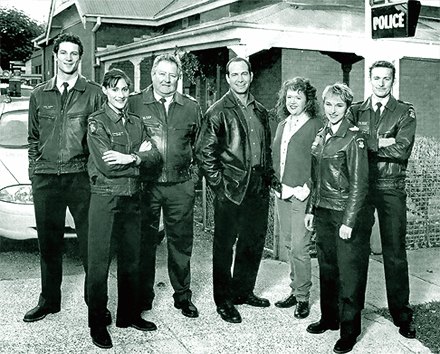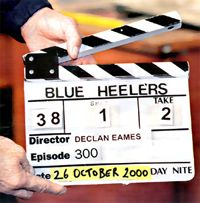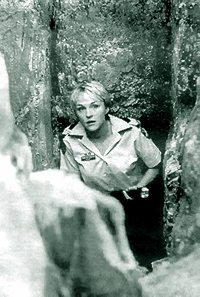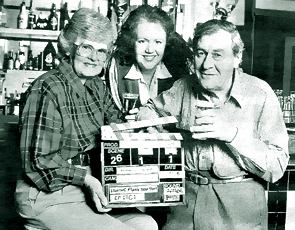Hard-working dogs

Police line-up: (from left) Rupert Reid, Jane Allsop, John Wood, Martin Sacks, Julie Nihill, Caroline Craig and Paul Bishop.
It is a chilly Castlemaine morning, the kind of weather Victoria does so well. For several days it has rained, closing a central Victorian highway, and the low-hanging clouds suggest more showers on the way. But still the people are out in force. A hundred or more. Many with cameras. Waiting for a glimpse of their idols.
It might have been knocked out of its long-held spot at the top of the all-important television ratings charts, but for Channel Seven, Blue Heelers is still a winner.
During a three-day visit to Castlemaine to shoot the episode's 300th episode — during which the cast and crew were also treated to a civic reception — the network's publicity department hands out cards, boxes of them, bearing a photo of the Heelers' cast. The actors hang around outside a cafe, signing autographs and chatting to their fans. Even the laborers working on a construction site over the road down their tools to join the throng.
Long-time favorites and original cast members John Wood and Martin Sacks are quickly surrounded by fans, including a trio who have driven from Broken Hill after hearing the Heelers would be in town.
Relative newcomer Jane Allsop is mobbed when she arrives late morning at the Empire Hotel — actually the facade of a second-hand clothing shop — to record promotional segments for the local Prime network. Allsop, who took out the most popular new talent award at the Logie Awards in May, signs autographs for about 10 minutes before being shepherded away to make-up.
Blue Heelers was born in early 1994 and by the end of its second season had firmed its place as a crowd favorite, making national celebrities of stars including Lisa McCune, Wood and Sacks. Even this year, Blue Heelers won the most popular program gong at the Logies. Sacks won Silver as most popular actor; McCune, who bowed out last year, won Silver for the most popular actress, then crowned her victory with the Gold Logie for most popular personality. It was McCune's fourth Gold Logie win, a record previously held only by TV veteran Graham Kennedy.
The Heelers' only serious competitor in the awards was the ABC's runaway hit — the show that knocked the Heelers off their ratings perch last year — SeaChange. The quirky drama earned the tag of the peer-voted, most-outstanding drama series. Its two stars Sigrid Thornton and William McInnes, himself a former Heeler, were named most outstanding actress and actor in a series.

Blue Heelers' executive producer Ric Pellezzeri believes the Heelers formula, simple as it is, has paved the way for the success of other dramas, including its most recent competitor.
"You can't take credit for SeaChange, but SeaChange's philosophy is very closely aligned to the Blue Heelers one except it's a lot more quirky," Pellezzeri says.
Both feature a close-knit community in a country town with strong moral and ethical structures. One is set around a police station, the other a court house. The episodes of both revolve around a matter in which someone is judged by the community to be right or wrong. And both centre around the romantic notion of escape.
"When we first started, we had two coppers just out of the city. Maggie and Wayne had just come from the city so they were escaping city life," he says.
"Those first 20 or 30 episodes were them coming to terms with being raw urban coppers in a country setting, which is not very different from Laura as an escapee from the city going to the country."
According to Pellezzeri, the formula has changed little since Blue Heelers premiered on Australian screens on January 18, 1994.
"It's a popular, recognisable genre, it's Australian country life, it's Australian characters. It's something to solve every week," he says.
"Our world is a place where we do look to sort things out. I think that's a comforting factor. Blue Heelers is able to create a reality. But it's a truth where there are people who will look after you, there are people who will help you.
"We try to be humanitarian. We actually believe in the value of human life and in the value of human relationship, of civil society, of community, of friendship, of loyalty and all those other things that are perhaps a little bit old-fashioned, but I believe are the glue and fabric of our society.
"So in many ways Blue Heelers reflects a lot of things that people want their society to be."

'Evil step-mother' Tess Gallagher: The new girl at Mount Thomas.
And they want to be protected by cops like Senior Sergeant Tom Croydon (Wood), Detective PJ Hasham (Sacks), Sergeant Tess Gallagher (Caroline Craig), Senior Constable Ben Stewart (Paul Bishop), Constable Jack Lawson (Rupert Reid) and Constable Jo Parrish (Allsop).
They haven't always been so confident. When the series started, Martin Sacks was so cynical about its future that he kept his Bondi apartment, "just in case", despite the production being set in Victoria. He laughs at the memory.
Sacks now sees what people are attracted to. It's the return to a simpler life, a life where problems arise, but are solved.
"It's got a little of that SeaChange phenomenon in a way. People romanticise about being in another time or another place and in the country," Sacks says.
"The show is built up very much so on family relationships. The Tom character might be the father, the PJ character might be the uncle, all the other characters are just very much like a family tree, and I think that's what the audience likes. There's a familiarity that they relate to, I think, like they do in a family."
Pellezzeri uses the same simile.
But the family is changing, a change brought on largely by the death of audience favorite, Maggie Doyle (McCune), shot by her corrupt cop brother early this year.
After a suitable period of mourning, Tess Gallagher was sent to Mount Thomas to liven things up.
Pellezzeri says there's need to keep the show fresh. That change is a good thing.
"The introduction of Tess was a very thought-out, planned thing," Pellezzeri says. "What we didn't want to do was bring in a Maggie clone — an audience had had a relationship with Maggie that had gone a long time. There was a lot of love for the character — so we had to really talk and think about what we were going to do, and what effect Tess would have on the universe.
"And we wanted to bring in a character that would shake our world up, shake our family up. We think of everything in family dynamics and Tom's the father, PJ's the uncle --"
Sacks chimes in: "We didn't rehearse this!"
"It's a world that we create. Maggie was the daughter that everybody wanted," Pellezzeri says.

[ ARTICLE EXCERPT ]
Heelers spoon out good medicine
YOU won't see their faces on the covers of glossy magazines and they don't get mobbed by fans in the street, yet they have appeared in more episodes of Blue Heelers than most of the cast.
They are the unsung originals in the Blue Heelers team, appearing on-screen in almost every episode.
For some seven years, Jack and Jane Paynting have made the trip from Bendigo to appear as extras in the series. A careful viewer will see them drinking beer in the pub or crossing the street in downtown Mount Thomas.
Among the crew they are known simply as Jack and Minnie and they have been with Blue Heelers almost since the beginning.
Jack, 76, says of his wife's moniker, now the only name by which she is known: "It all started when we went to the pictures and I said to her, 'Oh you remind me of Minnie the Moocher".
Jack's career as an extra started with the mini-series Eureka Stockade in 1984. Minnie joined him on-screen soon afterwards.
He says he has appeared in just about every major production in Victoria since, and rattles off a list including The Man from Snowy River, All the Rivers Run and series such as Stingers.
"You name it. They are always looking for some old codger, you know!" he says.
The Payntings' first appearance in Blue Heelers — Jack thinks it was in the 16th episode — was shot in Castlemaine in early 1994 and involved the re-enactment of an Anzac Day parade.
"I was playing two-up with Bud Tingwell," he says.
They have appeared in nearly every episode since, nudging close to the record held by John Wood's Senior Sergeant Tom Croydon, the only Heeler to have appeared in every show.
Now the couple looks forward to their regular outings, driving from Bendigo to Melbourne every week or two to appear.
"It keeps me out of mischief and trouble and all that. I suppose if we didn't do that we'd be stuck sitting at home by the telly. If you had nothing to look forward to over the next 12 months you'd just sit around and mope,' he says.
"Every time I say for a bit of a joke, 'Oh I think we'll cut this out', she's like, 'Oh, I'd never get out of the place, I'd never go anywhere!" he says.
"No, I'll just keep going until they say, 'You've had enough, you are too old'. It keeps us active. It's good medicine."
Kylie Miller
"And the girl that every boy wanted to go out with," Sacks adds.
Pellezzeri nods. "With Tess, we wanted to create someone who came in and stirred up the family. In a way, she is a big sister influence. She still hasn't grown up enough to be a big sister, but she's been given the role to play a big sister.
"So you've got a character who hasn't got her personal authority, who's given a role to play with authority and that's interesting, and then she's got to come in and impress Ds like PJ Hasham, who have been in the job a long time, and meantime she's got to maintain her strength and position in the station."
Craig, who was cast as Tess Gallagher immediately after graduating from NIDA, says she was told by the producers to see her character as the younger evil stepmother of the clan, making waves with her confidence and forceful, by-the-book city ways. In reality, Craig was a bundle of nerves, spilling coffee down her front during the taping of her first scene.
Tess, is really smooth and sharp, Craig says, laughing at the memory. "Caroline, the actor, let down Tess, the character. It was like, 'Yeah mate, we'll catch up for a short black sometime,' and I went ku-ching and completely missed my mouth."
The 300th episode is a big one for Craig, a storyline involving child abuse and what she calls "the greening of Tess".
"Tess is a very 'head' person and always goes by the book," she says. "This is the greening of Tess, the country evolution, and she stuffs up really badly and gets very involved in a child abuse case because she can relate it to her own childhood."
Viewers have seen only a hint of trouble in Sergeant Gallagher's past, but Craig jokes that she has inside running: "She tells me everything!"
Pellezzeri says it is typical of the issues that Blue Heelers addresses, another of the reasons for its lasting popularity.
"Ultimately it's an issues story. People say that Blue Heelers is soft. We are very issue-oriented," he says.
The stories deal with family issues, with working relationships, with political and council matters and with social, moral and ethical issues.
Recent episodes have dealt with school bullying, family breakup and disability, as Constable Jack Lawson found himself wheelchair-bound after a shooting.
"We do them within the structure of this small town of Mount Thomas and we do them so they are relevant to people who watch the show. We are a very working class show in many ways because we deal with very working class issues. The daily grind of our lives. Family values.
"If you looked back at the previous 299 episodes there's an issue in every one, there's a theme driving every one. And again we don't stand on soap boxes, we don't preach, we don't teach, we are there to entertain."
And with continued careful planning, the show may keep entertaining for a few years yet, says supervising producer Gus Howard.
While not achieving the massive ratings of a year or two ago — when individual episodes could score as high as 40 per cent of the viewing audience — the show consistently wins its timeslot with scores in the mid to high 20s, occasionally climbing to 30.
The ratings slide began in early 1998 when Blue Heelers was forced to vacate its plum Tuesday night timeslot to make way for Seven's new hospital drama, All Saints. The Heelers moved to 8.30pm on Wednesday.
"We haven't done as well since. Whoever has that 8.30 Tuesday slot is handed a beautiful time for Australian drama, but despite that shift the show is still a success."
Howard says he doesn't sweat on the ratings. "When you consider we do 42 eps a year, every year, it is inevitable that sooner or later someone's going to come up with something that attracts our audience," he says.
"We know who our audience is and if they are attracted to something else every now and again, we know why. And they always come back to us — we can't afford to be worried. We just try to be consistent.
"Across the board we'd have to still be the most successful show on television, drama-wise."
Hundreds of fans crowding the streets in Castlemaine obviously agree.